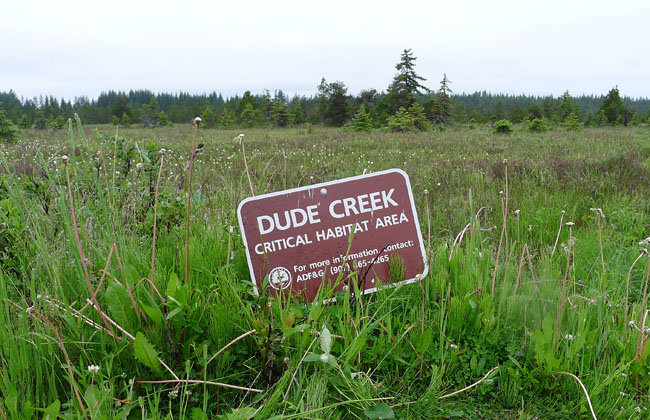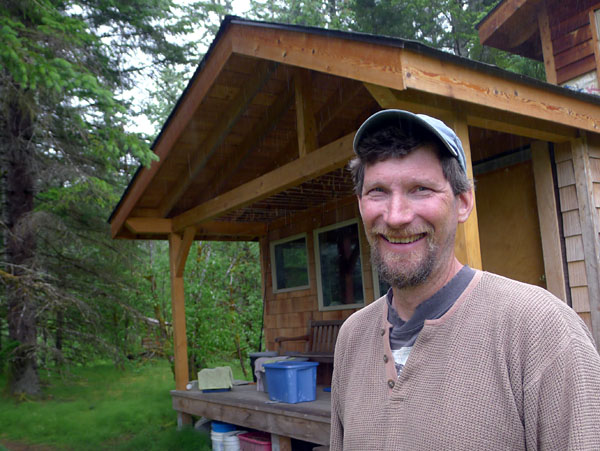
The Alaska Department of Fish and Game manages 3 million acres of protected land, and many areas have seen their share of controversy. In recent years, there have been questions about putting a jackup drill rig in Kachemak Bay and the proximity of a coal project to the Susitna Flats.
Now, the latest fight involves the Dude Creek Critical Habitat Area – a small reserve outside of Gustavus that’s used by sandhill cranes. For the past few years, government biologists and local stakeholders have been developing a management plan for the wetlands. But recently, that process took a radical turn, and the outcome could determine how all the state’s protected habitat is managed.
If you check out the latest version of the Dude Creek management plan, you’ll notice a few things. First, it’s covered in red edits. Second, it’s about half the length of the original. And third, the phrase “will not allow” has turned into “may allow.”
Hank Lentfer, a Gustavus resident who represented the Nature Conservancy on the planning team, wasn’t happy when he saw it.
“It was totally out of the blue,” says Lentfer. “It was just – it just came in e-mail, saying: ‘This is it. This is the new draft,’ radically different from the one that the planning team had signed off on, but all the members of the community that had been given a formal opportunity to comment. All those comments had been very thoughtfully summarized and included in that plan. And that’s all been gutted.”
Whole sections on scientific research and local knowledge were stripped. Hard prohibitions on geological exploration or hazardous waste disposal were gone. The way the new version approached activity that could change the land was to permit it on a case-by-case basis, and without public notice.
Lentfer thinks the changes are odd because Dude Creek is not desirable land for development. The ground beneath it is made of clay, and it’s hard to imagine any resource extraction or even building construction happening there.
To find out the reason for the new plan, I talked to Randy Bates, director of Fish and Game’s Habitat division. He says that because technology – and even the land itself – can change, he wants to move away from hard restrictions that could block development decades from now.
“The idea is can we get to yes instead of can we justify no,” Bates says.
The changes made to the draft aren’t just about Dude Creek. Of the 32 special areas that Habitat oversees, only about half of them have completed management plans. Dude Creek happened to be the one that Habitat staff was working on when Bates called for a new approach to their rules. And he says that yes, some of this language is “precedent setting.”
“So, the concept of these changes has really affected a really small-focused plan, and it’s really raised a stir,” Bates says. “If we were to implement this on the Susitna Flats, or the Redoubt Bay, or Kachemak Bay, it would have been the same sort of blow up, but this is much ado about nothing in this plan in many ways. It affects these other plans to a much greater extent.”

Part of why Lentfer and other Gustavus residents are troubled by this new approach is that it’s coming at the same time the Parnell administration is making an aggressive push to reform permitting. One of the governor’s big priorities is a bill that sets a higher bar for appealing a permitting decision and makes it easier for the state to issue general permits that don’t need public notice.
Bates says Habitat’s new permitting strategy has nothing to do with that.
“We’re not changing the planning process to exclude the public and just notify them,” he says. “We still have every intention to run the process the way it was, soliciting input, sitting down, understanding the concerns. We’re not cutting anybody out of this process.”
But internal documents obtained by APRN contradict that statement and show drastic changes ahead.
As of this month, work on all new management plans, including Dude Creek, has been put on hold. Instead, Habitat has been directed to revise all completed management plans in the Dude Creek style. Rather than go through the old process – which involved public scoping meetings, collaborative interagency planning teams, and a series of comment periods – Habitat will put multiple plans into one big regulatory review packet that will go out for comment once a year.
According to an e-mail Bates sent to the division, staff cannot discuss the management changes with the public without getting his approval. Sources within the department characterize it as a “gag order.” And meeting notes show that staff is raising many of the same questions as the public members of the planning team.
To read APRN’s full report on this topic, click here.
